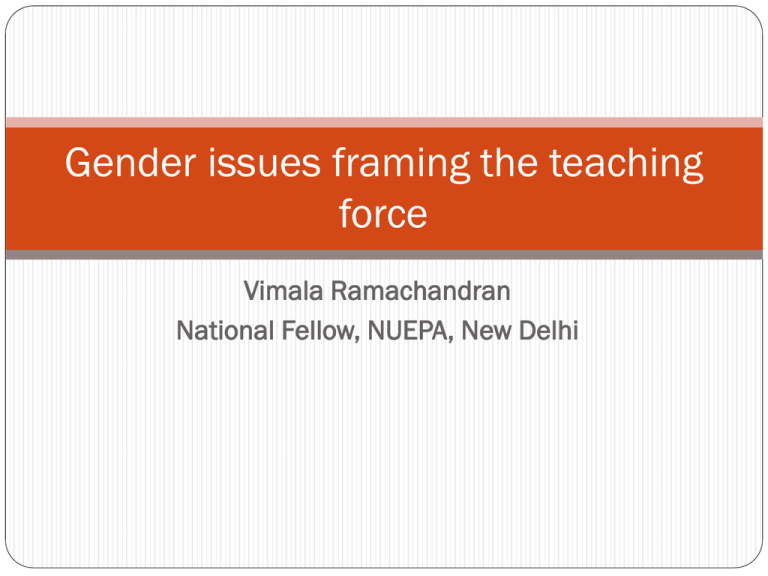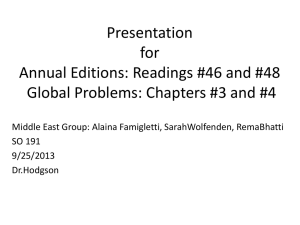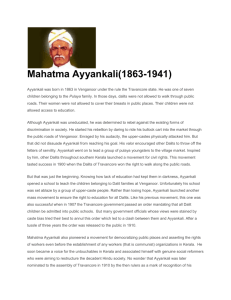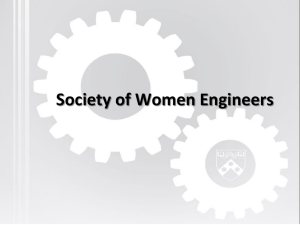
Gender issues framing the teaching
force
Vimala Ramachandran
National Fellow, NUEPA, New Delhi
Why gender?
Teachers and educators influence the gender roles of their
students thus impacting their educational outcomes. When
considering Education for All (EFA) goal 5, which aimed to
eliminate gender disparities in primary and secondary
education by 2005 and now aims to achieve gender equality
by 2015, it should be realized that teachers are a critical force
for meeting the goal” (Guidelines for inclusion, UNESCO,
2009)
Teachers as agents of change, teachers as harbingers of values
of equality and non-discrimination...
Teachers, being embedded in society may themselves be
subject to gender based exclusion / discrimination
2
29 May 2012
Why gender?
“The teacher, the learning environment and practices
within the school coalesce to affirm roles and
attitudes. A process that begins within the home gets
re-established and consolidated within the school...
The school teacher plays an important role in
maintaining, modifying and reshaping her
understanding of location, in terms of her class,
caste, gender, religion, sexuality and and region”
(NCF India, Gender issues in education, 2005)
3
29 May 2012
How gender is positioned?
While there is almost universal acceptance of the importance
4
of “Gender” , the way it is positioned raises questions:
It is mostly about tracking numbers – number of teachers,
number of students, absenteeism, number of training
attended....
Programmes monitor completion of activities and utilisation
of budgets, allocation of budgets for gender related areas
Gender is equated with women / girls (example fishing
community in Tsunami area of TN)
Mechanical screening of textbooks etc...( Dipta will talk
about this in her presentation)
29 May 2012
What is missing...
How gender issues manifest in everyday practice
of teaching and learning;
Attitudes, perceptions, prejudices that we all
carry with us into our work space...
Have we missed the substance and focusing more
on the form
When we talk about gender issues that frame the
teaching force in the world, it is important to go
beyond numbers and tokens...
5
29 May 2012
Feminisation
Feminisation of the teaching profession – at pre-primary,
primary and up to secondary proportion of women high
(regional variations exist) but at higher education levels it
goes down (vertical segregation) representation in
management / leadership roles also low (varies across
countries)
Should we work towards attracting more men to the teaching
force? Experience in Europe (EACEA, 2010)
Should we continue to push for more women in
Is there a hierarchy of disciplines (horizontal segregation) and
levels?
6
29 May 2012
Global issues
Need to work towards more women teachers in management and
leadership;
Glass ceiling, barriers to women reaching leadership positions?
Weave in gender as a topic in teacher education
Integration versus modules or separate courses.
Continuing professional development of women teachers
Gender bias in teacher education texts
Sexual harassment, safety issues...
What can teachers / teacher educators do to foster a sense of equality
between men and women, between different races, castes, communities
and religion?
How much can they do?
It is about justice and equal opportunities
Its about men and women
7
29 May 2012
The Indian Scenario
Policies recommend more female teachers – especially in
DPEP and now SSA, special programmes (NPEGEL) or
schools (KGBV) for girls
Gender = Girls
Proportion of female teachers (grades 1-12) around 40
percent
Huge urban-rural differences
Enormous variation across different states of India
Higher in private schools (53%)
Caste and gender hierarchies in appointment of para-teachers
(Probe, revisited 2011).
8
29 May 2012
Huge variations across India
2010-11
Government Schools
% of Women
(Regular) Teachers Primary, Upper Primary
All India
40.68
Assam
31.55
Jharkhand
25.77
Kerala
68.84
Madhya Pradesh
30.94
Maharashtra
39.07
Rajasthan
28.39
T Nadu
68.85
West Bengal
39.76
2010-11
Private schools
Primary, Upper
Primary
54.65
29.61
44.80
74.75
55.27
50.75
32.59
84.48
55.95
Note: Primary & Upper Primary with Secondary and Higher
secondary included, but not stand alone secondary or higher
secondary schools. Source DISE
9
29 May 2012
SES, GOI (200708)
Higher
secondary
schools
Middle
Pre-primary
High school (Senior Basic
& Junior
(post basic)
Schools)
Basic
% female teachers (regular) per 100 male teachers
All India
Assam
Jharkhand
Kerala
Madhya Pradesh
Maharashtra
Rajasthan
T Nadu
West Bengal
10
58
47
82
283
62
47
41
97
47
61
35
42
258
63
46
33
146
39
67
35
23
230
28 (?)
79
44
151
38
80
54
58
299
45 (?)
152
44
284
40
29 May 2012
Complex web of social norms
Social norms instrumental in encouraging women to become
teachers
However lack of other employment opportunities for men,
pushes many into teaching;
Low female literacy and patriarchal values have had negative
impact in some states
Hierarchies within:
Pre-school, primary, upper primary, secondary, university,
Government teachers, local power and influence versus private teachers
Few in leadership positions: headmasters, head teachers, educational
administrators, BRC (Kerala and TN notable exceptions)
11
29 May 2012
Becoming a teacher
Teacher training courses popular among girls who
complete secondary education
Access to secondary education remains a challenge
Fees, including capitation in private institutions
Ability to study math and science in higher secondary (Visaria’s
study, 2009)
Patriarchal norms come in the way of participation in in-
service training (especially residential)
12
29 May 2012
On the brighter side
Absenteeism lower among women teachers
(Kremer et al, 2005)
More motivated, focus on school and children;
not given to participating in local politics (Jha and
Bharadwaj 2001 and Ramachandran et al 2004,
Rajagopal 2009)
Female head teachers less engaged in politics and
more engaged with school (De et al 2005,
Samson et al 2007).
13
29 May 2012
Recurring recommendations
Do not address gender issues mechanically:
Equal attention to substance, attitudes, practices
Devise need situation specific strategies;
Enable more girls to move to secondary education, make
sure science, math is offered;
Enhance opportunities for women in most deprived
social groups / races / locations to transition from
secondary to teacher training course
Mentor and nurture women to take leadership positions
14
29 May 2012
Recurring recommendations 2
Enable women teachers to form an association /
forum to address specific problems / issues and
provide support:
Academic – teacher training, continuing education,
leadership training
Non-academic – safety, sexual harassment,
discrimination, stereotyping
15
29 May 2012
Recurring recommendations 3
Teacher training:
Pay attention to experiences of teachers, the problems they face
on the ground
Factor in perspectives and priorities of different kinds of
teachers and those from different social groups
Look at manifest and hidden hierarchies – and address all
of them together (do not do them in silos):
16
Caste / race / community / location
Gender
Ability / disability
Health (HIV positive, other ailments that lead to prejudices)
29 May 2012
A lot to do
Lets not become complacent...
Numbers are just one dimension of
gender.... Go beyond numbers, ratios,
percentages and focus on the twists and
turns of everyday practice of teachers.
THANK YOU!
17
29 May 2012












